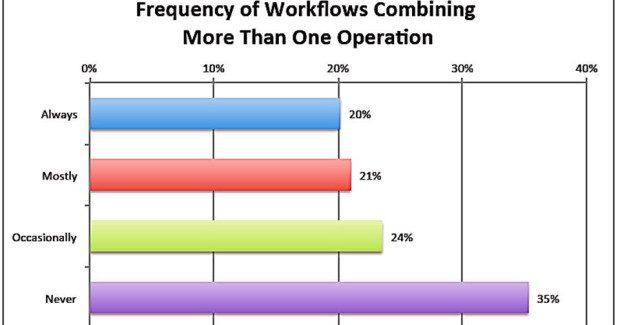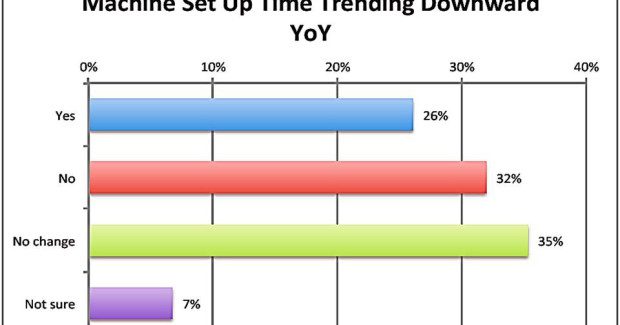Benchmark Survey of Industrial Metal-Cutting Organizations
Amid a challenging operating environment, the LENOX Institute of Technology conducted a survey of 100+ industrial metal cutting operations that identified three key areas where organizations can gain additional productivity and efficiency on the shop floor.
Posted: April 24, 2014
The LENOX Institute of Technology (LIT; East Longmeadow, MA) conducted a survey of 100+ industrial metal cutting operations in mid-2013. Amid a challenging operating environment, the survey identified three key areas where organizations can gain additional productivity and efficiency on the shop floor.
These include (1) invest in smarter, more predictive operations management; (2) embrace proactive care and maintenance of saws and saw blades; and (3) invest in human capital. The survey results also provide insights around production process efficiency, metal cutting machine metrics, operator training and performance, quality and cost, as well as machine (saws) and tooling (blades) maintenance.
Metal fabricators (37 percent) and metal service centers (29 percent) made up the majority of the survey sample, followed by machine shops (18 percent), with a smaller proportion of respondents falling into the forge (4 percent), tube mill (2 percent) or “other” (10 percent) categories. This survey was focused on organizations that employ tool-based machines to cut metal. Laser and water jet machines were not included in this study.
KEY INSIGHTS
Uncertainty about external factors, such as the pace of economic activity and commodities pricing, has pushed metal-cutting companies to increasingly focus on improving those aspects of their business that are within their control — primarily, internal operations.[1]
In a recent survey by PricewaterhouseCoopers, 56 percent of metals CEOs listed improving operational effectiveness as one of their key investment priorities.[2] Specifically, the report noted, “Cost-cutting and operational efficiency are high on the agenda.”
While many of today’s metal cutting companies exist because of their ability to survive even the toughest market conditions, best-in-class operations know they cannot afford to rest on their laurels. Today’s industry leaders are taking a proactive approach to optimizing industrial metal cutting operations so that they are in the best position possible as demand returns.[1] This includes addressing traditional pain points, such as efficiency and cost, while also tackling new challenges in areas such as workforce development and changing customer requirements.
Despite a trend toward internal process improvements, machine downtime, blade failure and operator error remain the top-three sources of frustration for industrial metal cutting operations on the shop floor.[3]
- Machine downtime 34.75 percent
- Blade failure 27.12 percent
- Operator errors 15.25 percent
- Time to job completion 7.63 percent
- Excess scrap 3.39 percent
- Finding the right blade (tool) 2.54 percent
- Meeting production requirements 2.54 percent
- Quality assurance 2.54 percent
- Blade availability 0.85 percent
- Cutting equipment vendor relationship 0.85 percent
- Excess raw material inventory 0.85 percent
- Operator turnover 0.85 percent
- Rework 0.85 percent
So what are new strategies companies can employ to continue to improve and attack these top-three issues? As indicated above, the survey identified three key areas where organizations can gain additional productivity and efficiency on the shop floor.
1) INVEST IN SMARTER, MORE
Predictive Operations Management
Seventy-three percent of respondents said their metal-cutting machine uptime is greater than 75 percent “always” or “mostly”; thus, machine downtime, partially caused by blade failure, is something no shop can afford (see Figure 1).
Data from the survey suggests that companies with high machine uptime can benefit from investing in smarter, more predictive and more agile operations management approaches.
Sixty-seven percent of industrial metal cutting operations that follow all scheduled and planned maintenance on their machines also report that their job completion rate is trending upward year over year – a meaningful correlation. The implication is that less disruptive, unplanned downtime and more anticipated, planned downtime translates into more jobs being completed on time.
Slightly more than half (51 percent) of organizations that “always” follow scheduled and preventative maintenance plans say that blade failure is predicted “always” or “mostly.”
Preventative maintenance clearly helps industrial metal cutting operations predict blade failure; in fact, operations management can plan for downtime. And there is a major difference between “predictive downtime,” which can actually improve cutting performance and extend equipment life, versus “interruptive downtime,” which can hurt performance and impact on-time customer delivery, while also increasing material costs.
Additional Findings
In addition to the key findings above, survey participants provided valuable insights on the topics of production process efficiency, cutting machine metrics, operator training and performance, quality and cost, as well as machine (saws) and tooling (blades) maintenance.
Production Process Efficiency
Ninety-eight percent of survey respondents said they’re either “always” (39 percent) or “mostly” (60 percent) able to meet customer demand. In fact, the study found a correlation between an organization’s frequency of meeting customer demand and having the right number of machines for the jobs.
In terms of how frequently organizations employ workflows that combine more than one operation, there was not a consistent trend; in fact, 35 percent of respondents indicated they “never” do this. How often do metal cutting operations bundle? Only 11 percent said they “always” bundle materials for metal cutting (see Figures 5, 6).
Cutting Machine Metrics
As noted earlier, 73 percent of respondents report their metal cutting equipment is in good running order most of the time. When asked how frequently machine uptime was greater than 75 percent, 26 percent of respondents said “always” and 47 percent said “mostly.”
In terms of whether respondents’ cutting machine cycle time and setup time are trending downward year-over-year, only 10 percent of respondents reported a downward trend in cycle times (see Figure 7). Respondents were more likely to report “no change” (39 percent) or “no” (39 percent) – indicating cycle times are probably increasing in the aggregate.
Only 26 percent of respondents said their cutting machine setup time is actually trending downward year over year (see Figure 8). Forty-four percent of survey participants said their job completion rate is trending upward year-over-year (see Figure 9).
2) EMBRACE PROACTIVE CARE & MAINTENANCE OF SAWS & SAW BLADES
Seventy percent of organizations that report their scrap and rework costs are less than five percent also say they “always” break in their band saw blades. This provides strong economic validation for the proactive care of saws and blades. By breaking in blades properly, organizations are able to reduce “soft” failure that leads to waste and scrap and that eats into their bottom line (see Figure 2).
Clearly, ongoing operator monitoring, coupled with corrective instruction and coaching, can have a direct benefit on industrial metal cutting operations – improving their ability to meet customer demands, drive revenues and lower costs (see Figure 4).
3) INVEST IN HUMAN CAPITAL
While industry data indicates that metal executives often prefer to invest in technology, rather than their people [2], LIT’s survey provides evidence that investing in human capital is critical not only to attack operator error itself, but also to improve on-time customer delivery, drive higher revenue per operator and lower rework costs.
Sixty-four percent of organizations that cite their metal-cutting operator turnover is decreasing year-over-year, also report on-time job completion is trending upward – a critical correlation. In addition to this, 51 percent of organizations that reported reduced levels of operator turnover also said their revenue per operator had increased (see Figure 3).
Finally, regardless of the percentage of machine uptime reported, respondents admitted that finished products don’t pass first inspection 20 percent of the time and require rework. This is not a machine issue; it’s recurring operator error, which only ongoing training and accountability can remedy. Yet, too often metal cutting operations only provide upfront training, as opposed to continually reinvesting in their operators.
Operator Training & Performance
Operator training and education most often included these five tactics:
1. A formal training process that demonstrates the operation step-by-step
2. An informal training process in which operators learn by watching peers
3. Training of all metal cutting operators on standardized equipment
4. Consistent measurement of operator performance
5. Conducting regular safety training
While nearly half (47 percent) of respondents reported “no change” in their metal cutting operator turnover year-over-year, 33 percent said their operator turnover is decreasing. When asked whether their operator revenue per hour is increasing year-over-year, 33 percent reported an increase in operator revenue per hour – more than twice the amount that said “no.”
In terms of a reduction year-over-year in the number of job-related operator accidents, an encouraging 95 percent of organizations boasted either a decrease (50 percent) or “no change” (45 percent). Only 1 percent of metal operations said that they’ve seen an increase in job-related operator accidents.
Quality
On the topic of quality, survey questions included how often metal cutting operations collect and report on customer feedback and use the data to improve overall customer satisfaction, as well as how frequently organizations’ finished product required rework due to not passing first inspection.
Fifty-one percent of respondents said they “always” (34 percent) use customer feedback or that they use it “mostly” (17 percent) to improve satisfaction. Twenty-nine percent said they “occasionally” use customer feedback to this end. Seventeen percent, however, admitted they “never” use customer feedback to improve satisfaction.
Interestingly, the lion’s share (79 percent) of respondents reported that they “occasionally” have to rework their finished product because it did not pass first inspection. While high, this does imply a strong awareness of material not being cut correctly the first time, alongside quality control (QC) initiatives to catch erroneous parts and get them right before they leave the facility and are shipped to customers. A healthy ratio (20 percent) also said they “never” have to rework finished product.
Cost
A vast majority of respondents – 81 percent collectively – said their scrap and re-work costs are “always” (23 percent), “mostly” (45 percent) or “occasionally” less than 5 percent. The survey also asked respondents if their per-unit manufacturing costs are on a downtrend. Twenty-eight percent said “yes,” 20 percent said “no,” (that their per-unit manufacturing costs had in fact increased), and 31 percent said they had seen “no change”(see Figure 10).
Metal Cutting Machines and Blades
Figures on preventive maintenance, blade break-in procedure and predictive blade failure were encouraging. Seventy-two percent of respondents reported that they “always” (28 percent) follow preventive maintenance, or that they adhere to it most of the time (44 percent). Twenty-one percent said they “occasionally” follow preventive maintenance process. While significantly lower, seven percent admitted they “never” follow preventive maintenance procedures.
It appears that blade break-in procedure is a priority both in theory and practice among metal cutting operations. A collective 75 percent of organizations surveyed reported they “always” (45 percent) break in blades or that they do it most of the time (30 percent). Still another 15 percent said they “occasionally” break in blades.
While a collective 66 percent of respondents reported that they “always” (9 percent) or “occasionally” (29 percent) predict blade failure, or that they are able to predict it most of the time (28 percent), another 28 percent say they “never” predict blade failure, which suggests there are strides for the industry to make in the area of proactive preventative maintenance and predictive downtime.
Conclusion
Metal-cutting operations will continue to look for ways to improve performance. This study revealed three key areas for possible improvement without adding new capital expense. By both identifying and addressing new opportunities for efficiency, managers can ensure that their operations will be successful in continuing to meet customer demand and improving the bottom line.
Sources
1. Modern Metals, “A Revamped, Refined Business Plan,” May 2013.
2. PwC 16th Annual Global CEO Survey, “Dealing with Disruption,” February 2013.
3. LENOX Institute of Technology, “Industrial Metal Cutting Benchmark Study,” 2013.
The LENOX Institute of Technology is dedicated to developing world class industry experts in the field of metal material separation, using expertise and innovative instructional techniques as a catalyst to push participants to their next level of performance with hands-on methods to share solutions that endure through ever-changing environments.
lenoxtools.com/industrialresourcecenter

























